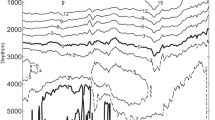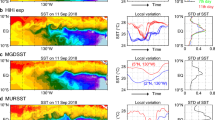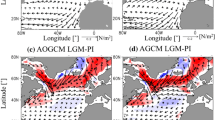Abstract
Estimating the processes that control the north equatorial sea surface temperature (SST)-front on the northern edge of the cold tongue in the tropical Atlantic is a key issue for understanding the dynamics of the oceanic equatorial Atlantic and the West African Monsoon. Diagnosis of the frontogenetic forcings on a realistic high-resolution simulation was used to identify the processes involved in the formation and evolution of the equatorial SST-front. The turbulent forcing associated with the mixed-layer turbulent heat flux was found to be systematically frontolytic while the dynamic forcing associated with currents was found to be frontogenetic for the equatorial SST-front. Nevertheless, the low-frequency component of the turbulent forcing was frontogenetic and initiated the SST-front which was then amplified and maintained by the leading dynamic forcing. This forcing was mainly driven by the meridional convergence of the northern South Equatorial Current (nSEC) and the Guinea Current, which points out the essential role played by the circulation in the equatorial SST-front evolution. The quasi-biweekly variability of the equatorial SST-front and its forcings were found to be more strongly coupled to the wind energy flux (WEF) than to the surface wind stress. In fact the WEF controlled the convergence/divergence of the nSEC and Guinea Current and thus the meridional component of the leading dynamic forcing. The WEF explains the equatorial SST-front development better than the wind does because it is a coupled ocean-atmosphere process.












Similar content being viewed by others
References
Arnault S (1987) Tropical Atlantic geostrophic currents and ship drifts. J Phys Oceanogr 18:1050–1060
Back L, Bretherton C (2009) On the relationship between SST gradients, boundary layer winds, and convergence over the tropical nceans. J Clim 22:4182–4196
Blanke B, Delecluse P (1993) Low frequency variability of the tropical ocean simulated by a general circulation model with mixed layer physics. J Phys Oceanogr 23:1363–1388
Bourlès B et al (2008) The PIRATA program: history, accomplishments and future directions. Bull Am Meteorol Soc 89:1111–1125
Bourlès B, Brandt P, Caniaux G, Dengler M, Gouriou Y, Key E, Lumpkin R, Marin F, Molinari R, Schmid C (2007) African Monsoon Multidisciplinary Analysis (AMMA): special measurements in the Tropical Atlantic. CLIVAR Newsl Exch 41:7–9
Bourlès B, D’Orgeville M, Eldin G, Gouriou Y, Chuchla R, DuPenhoat Y (2002) On the evolution of the thermocline and subthermocline eastward currents in the Equatorial Atlantic. Geophys Res Lett 29:16. doi:10.1029/2002GL015,098
Bourras D, Reverdin G, Giordani H, Caniaux G (2004) Response of the Atmospheric Boundary Layer to a Mesoscale Oceanic Eddy in the Northeast Atlantic. J Geophys Res 109:D18114. doi:10.1029/2004JD004,799
Caniaux G, Giordani H, Redelsperger J, Guichard F, Key E, Wade M (2011) Coupling between the Atlantic cold tongue and the West African monsoon in boreal spring and summer. J Geophys Res 116:C04003. doi:10.1029/2010JC006,570
Caniaux G, Planton S (1998) A 3D ocean mesoscale simulation using data from the SEMAPHORE experiment: mixed layer heat budget. J Geophys Res 103:2581–2599
Chelton D, Esbensen S, Schlax M, Thum N, Freilich M, Wentz F, Gentemann C, McPhaden M, Schopf P (2001) Observation of coupling between surface wind stress and sea surface temperature in the Eastern Tropical Pacific. J Clim 14:1479–1498
Colin C (1989) Sur la variabilité dans le Golfe de Guinée. Nouvelles considérations sur les mécanismes d’upwelling. Ph.D. thesis, Muséum National d’Histoire Naturelle de Paris
De Coëtlogon G, Janicot S, Lazar A (2010) Intraseasonal variability of the ocean-atmosphere coupling in the Gulf of Guinea during boreal spring and summer. Quart J R Meteorol Soc 109:C120031. doi:10.1029/2004JC002,378
De Szoeke S, Bond N, Cronin M, Morley B (2005) EPIC \(95^o\)W observations of the eastern Pacific atmospheric boundary layer from the cold tongue to the ITCZ. J Atmos Sci 62:426–442
De Szoeke S, Bretherton C (2004) Quasi-Lagrangian large eddy simulations of cross-equatorial flow in the east Pacific atmospheric boundary layer. J Atmos Sci 61:1837–1858
De Szoeke S, Xie S, Miyama T, Richards K, Small R (2007) What maintains the SST front north of the eastern PacificEquatorial cold tongue. J Clim 20:2500–2514
Deser C, Wahl S, Bates J (1993) The influence of sea surface temperature gradients on stratiform cloudiness along the equatorial front in the Pacific Ocean. J Clim 6:1172–1180
Dutrieux P, Menkès C, Vialard J, Flament P, Blanke B (2008) Lagrangian study of tropical instability vortices in the Atlantic. J Phys Oceanogr 38:400–417. doi:10.1175/2007JPO3763.1
Foltz G, Grodsky S, Carton JA, McPhaden M (2003) Seasonal mixed layer heat budget of the tropical Atlantic ocean. J Geophys Res 108(C5):3146. doi:10.1029/2002JC001,584
Gaspar P, Grégoris Y, Lefevre J (1990a) A simple eddy kinetic energy model for simulations of the oceanic vertical mixing: tests at station papa and long-term Upper Ocean study site. J Geophys Res 95:16,179–16,193
Giordani H, Caniaux G (2001) Sensitivity of cyclogenesis to sea surface temperature in the Northwestern Atlantic. Mon Weather Rev 129:1273–1295
Giordani H, Caniaux G (2011) Diagnosing vertical motion in the Equatorial Atlantic. Ocean Dyn. doi:10.1007/s10,236-011-0467-7
Giordani H, Caniaux G, Prieur L (2005a) A simplified oceanic model assimilating geostrophic currents: application to the POMME experiment. J Phys Oceanogr 35:628–644
Giordani H, Caniaux G, Prieur L, Paci A, Giraud S (2005b) A one year mesoscale simulation of the Northeast Atlantic: mixed layer heat and mass budgets during the POMME experiment. J Geophys Res 110:C07S08. doi:10.1029/2004JC002,765
Giordani H, Caniaux G, Voldoire A (2013) Intraseasonal mixed-layer heat budget in the Equatorial Atlantic during the Cold Tongue development in 2006. J Geophys Res 2013. doi:10.1029/2012JC008,280.
Giordani H, Planton S (2000) Modeling and analysis of ageostrophic circulation over the azores oceanic front during the SEMAPHORE experiment. Mon Weather Rev 128:2270–2287
Giordani H, Prieur L, Caniaux G (2006) Advanced insights into sources of vertical velocity in the ocean. Ocean Dyn 56. doi:10.1007/s10,236-005-0050-1
Goni GJ, Baringer M (2002) Surface currents in the tropical Atlantic across high density XBT line AX08. Geophys Res Lett 29(24). doi:10.1029/2002GL015,873
Gu G, Adler R (2004) Seasonal evolution and variability associated with the West African monsoon system. J Clim 17. doi:10.1175/1520-0442(2004)017
Hastenrath S, Lamb P (1978) On the dynamics and climatology of surface flow over the equatorial oceans. Tellus 30:436–448
Hayes S, McPhaden M, Wallace J (1989) The influence of sea surface temperature on surface wind in the eastern equatorial Pacific: weekly to monthly variability. J Clim 2:1500–1506
Hoskins B, Karoly D (1981) The steady linear response of a spherical atmosphere to thermal and orographic forcing. J Atmos Sci 38:1179–1196
Hummels R, Dengler M, Bourlès B (2013) Seasonal and regional variability of upper ocean diapycnal heat flux in the Atlantic Cold Tongue. Progress in Oceanography in press, 2013. doi:10.1016/jpocean.2012.11.001
Jochum M, Murtugudde R (2006) Temperature advection by tropical instability waves. J Phys Oceanogr 36:592–605
Josse P (1999) Modélisation couplée Océan-Atmosphère à méso-échelle: application à la campagne SEMAPHORE. Ph.D. thesis, Université Paul Sabatier. Toulouse
Jouanno J, Marin F, duPenhoat Y, Sheinbaum J (2011) Seasonal heat balance in the upper 100 m of the Equatorial Atlantic Ocean. J Geophys Res. doi:10.1029/2010JC006912, in press.
Kantha L, Clayson C (1994) An improved mixed layer model for geosphysical applications. J Geophys Res 25:235–266
Klein P, Lapeyre G, Large W (2004) Wind ringing of the ocean in presence of mesoscale eddies. Geophys Res Lett 31:L15306. doi:10.1029/2004GL020,274
Large W, McWilliams J, Doney S (1994) Ocean vertical mixing: a review and a model with nonlocal boundary layer parameterization. Rev Geophys 32:363–403
Leduc-Leballeur M, Eymard L, Coëtlogon GD (2011) Observation of the marine atmospheric boundary layer in the gulf of guinea during the 2006 boreal spring. Quart J R Meteorol Soc 137:992–1003. doi:10.1002/qj.808
Legeckis R, Reverdin G (1987) Long waves in the equatorial Atlantic Ocean during 1983. J Geophys Res 92(C3):2835–2842
Lemasson L, Rebert J (1969) Observations de courants sur le plateau continental ivoirien: mise en vidence d’un sous-courant. Doc Sci Prov 022:1–66
Leslie L, Miles G, Gauntlett D (1981) The impact of FGGE data coverage and improved numerical techniques in numerical weather prediction in the Australian region. Quart J R Meteorol Soc. 107:627–642
Lumpkin R, Garzoli S (2005) Near-surface circulation in the tropical Atlantic ocean. Deep Sea Res 52:495–518. doi:10.1016/j.dsr.2004.09.001
Madec G, Delécluse P, Imbard M, Lévy C (1998) OPA8.1 Ocean general circulation model reference manual. In: Technoical report LOCEAN, Universit P. et M. Curie, B102 T15–E5, 4 place Jussieu, Paris cedex 5
Marin F, Caniaux G, Bourlès B, Giordani H, Gouriou Y, Key E (2009) Why were sea surface temperatures so different in the Eastern Equatorial Atlantic in June 2005 and 2006? J Phys Oceanogr 39:1416–1431
Menkes C, Vialard J, Kennan S, Boulanger JH, Madec G (2006) A modeling study of the impact of tropical instability waves on the heat budget of the eastern equatorial Pacific. J Phys Oceanogr 36:847–865
Merle J, Fieux M, Hisard P (1979) Annual signal and interannual anomalies of sea surface temperature in the eastern equatorial Atlantic Ocean. Deep Sea Res 26:77–101
Nguyen H, Thorncroft C, Zhang C (2011) Guinean coastal rainfall of the west African monsoon. Quart J R Meteorol Soc 137(660):1828–1840
Okumura Y, Xie S (2004) Interaction of the Atlantic equatorial Cold Tongue and the African Monsoon. J Clim 17:3589–3602
Perez R, Cronin M, Kessler W (2010) Tropical cells and a secondary circulation near the northern front of the Equatorial Pacific cold tongue. J Phys Oceanogr 40:2091–2106. doi:10.1175/2010JPO4366.1
Perez R, Hormann V, Lumpkin R, Brandt P, Johns W, Hernandez F, Schmid C, Bourlès B (2013) Mean meridional currents in the central and eastern equatorial Atlantic. Clim Dyn. doi:10.1007/s00,382-013-1968-5
Perez R, Lumpkin R, Johns W, Foltz G, Hormann V (2012) Interannual variations of Atlantic tropical instability waves. J Geophys Res 117:C03011. doi:10.1029/2011JC007,584
Peter C, Hénaff ML, du Penhoat Y, Menkès C, Marin F, Vialard J, Caniaux G, Lazar A (2006) A model study of the seasonal mixed-layer heat budget in the equatorial Atlantic. J Geophys Res 111:C06014. doi:10.1029/2005JC003,157
Picaut J (1983) Propagation of the seasonal upwelling in the eastern equatorial Atlantic. J Phys Oceanogr 13:77–101
Redelsperger J, Thorncroft C, Diedhiou A, Lebel T, Parker D (2006) African Monsoon Multidisciplinary Analysis: an international project and field campaign. Bull Am Meteorol Soc 87:1739–1746. doi:10.1175/BAMS-87-12-1739
Richardson P, Philander S (1987) The seasonal variations of surface currents in the tropical Atlantic ocean: a comparison of ship drift data with results from a general circulation model. J Geophys Res 92:715–724
Richardson P, Walsh D (1986) Mapping climatological seasonal variations of surface currents in the tropical Atlantic using ship drifts. J Geophys Res 91(C9):10,537–10,550
Seo H, Jochum M, Murtugudde R, Miller A (2006) Effect of ocean mesoscale variability on the ocean state of tropical Atlantic climate. Geophys Res Lett 33:LO9606. doi:10.1029/2005GL0256,651
Small R, deSzoeke S, Xie S, O’Neill L, Seo H, Song Q, Cornillon P, Spall M, Minobe S (2008) Air–sea interaction over ocean fronts and eddies. Dyn Atmos Oceans 45:274–319. doi:10.1016/j.dynatmoce.2008.01.001
Small R, Xie S, Wang Y, Esbensen S, Vickers D (2005) Numerical simulation of boundary layer structure and cross-equatorial flow in the eastern Pacific. J Atmos Sci 62:1812–1830
Steger J, Carton J (1991) Long waves end eddies in the tropical Atlantic Ocean:1984–1990. J Geophys Res 96(C08):15 161–15 171
Stramma L, Schott F (1996) Western equatorial circulation and interhemispheric exchange. In: Krauss W (ed) The Warmwatersphere of the North Atlantic Ocean. Gebr, Borntraeger, Berlin, Stuttgart, pp 195–227
Strass VH (1994) Mesoscale Instability and Upwellwing. Part II: testing the diagnostics of vertical motion with a three-dimensional ocean front model. J Phys Oceanogr 24:1759–1767
Sweet W, JK, Fett R, Violette PL (1981) Air–sea interaction effects in the lower troposphere across the north wall of the Gulf Stream. Mon Weather Rev 109:1042–1052
Thomas L, Lee C (2005) Intensification of ocean fronts by down-front winds. J Phys Oceanogr 35:1086–1102
Thorncroft C, Nguyen H, Zhang C, Peyrillé P (2011) Annual cycle of the West African monsoon: regional circulations and associated water vapour transport. Quart J R Meteorol Soc. doi:10.1002/qj.728
Wade M, Caniaux G, DuPenhoat Y (2011) Variability of the mixed layer heat budget in the eastern equatorial Atlantic during 2005–2007 as inferred using ARGO floats. J Geophys Res 116:C08006. doi:10.1029/2010JC006,683
Wade M, Caniaux G, DuPenhoat Y, Dengler M, Giordani H, Hummels R (2010) A one-dimensional modeling study of the diurnal cycle in the equatorial Atlantic at the PIRATA buoys during the EGEE-3 campaign. Ocean Dyn 61:513–524. doi:10.1007/s10,236-010-0337-8
Waliser D, Gautier C (1993) A satellite-derived climatology of the ITCZ. J Clim 6:2162–2174
Wallace J, Mitchell T, Deser C (1989) The influence of sea surface temperature on surface wind in the eastern equatorial Pacific: seasonal and interannual variability. J Clim 2:1492–1499
Wauthy B (1983) Introduction à la climatologie du Golfe de Guinée. Océanogr Trop 18(2):103–138
Weingartner T, Weisberg R (1991) A description of the annual cycle in sea surface temperature and upper ocean heat in the equatorial Atlantic. J Phys Oceanogr 21:83–96
Xie S (2004) The shape of continents, air–sea interaction, and the rising branch of the Hadley circulation. In: Diaz HR, Bradley RS (eds) The Hadley circulation: present, past and future. Kluwer Academic Press, Dordrecht, pp 121–152
Acknowledgments
This work was supported by the French programmes AMMA-EGEE (GAME/INSU). This study was supported by the AMMA project. Based on a French initiative, AMMA was built by an international scientific group and is currently funded by a large number of agencies, in France, the UK, the US and Africa. It has been the beneficiary of a major financial contribution from the European Community’s Sixth Framework Research Programme. Detailed information on scientific coordination and funding is available on the AMMA International website http://www.amma-international.org.
Author information
Authors and Affiliations
Corresponding author
Additional information
This paper is a contribution to the special issue on tropical Atlantic variability and coupled model climate biases that have been the focus of the recently completed Tropical Atlantic Climate Experiment (TACE), an international CLIVAR program (http://www.clivar.org/organization/atlantic/tace). This special issue is coordinated by William Johns, Peter Brandt, and Ping Chang, representatives of the TACE Observations and TACE Modeling and Synthesis working groups.
Rights and permissions
About this article
Cite this article
Giordani, H., Caniaux, G. Lagrangian sources of frontogenesis in the equatorial Atlantic front. Clim Dyn 43, 3147–3162 (2014). https://doi.org/10.1007/s00382-014-2293-3
Received:
Accepted:
Published:
Issue Date:
DOI: https://doi.org/10.1007/s00382-014-2293-3




